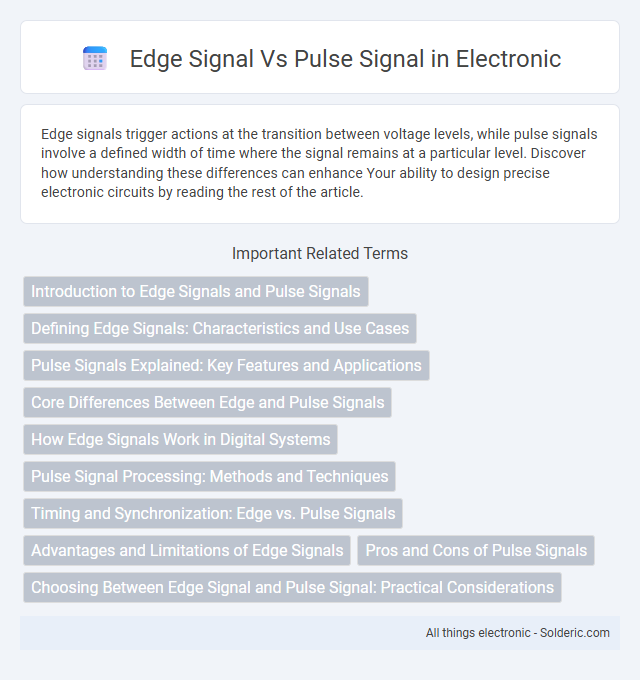Edge signals trigger actions at the transition between voltage levels, while pulse signals involve a defined width of time where the signal remains at a particular level. Discover how understanding these differences can enhance Your ability to design precise electronic circuits by reading the rest of the article.
Comparison Table
| Feature | Edge Signal | Pulse Signal |
|---|---|---|
| Definition | A change in signal voltage from low to high (rising edge) or high to low (falling edge) | A signal that stays high or low for a specific duration, representing a pulse width |
| Characteristics | Instantaneous transition | Finite duration with start and end |
| Use Cases | Trigger events, timing references, interrupts | Data communication, clock pulses, PWM signals |
| Signal Shape | Sharp transition without duration | Rectangular waveform with defined width |
| Measurement Focus | Timing of change point | Pulse width and repetition rate |
| Typical Applications | Edge detection in digital circuits | Modulation and encoding schemes |
Introduction to Edge Signals and Pulse Signals
Edge signals represent sudden transitions between voltage levels, typically used to trigger digital circuits at specific moments. Pulse signals consist of short bursts of energy with defined duration and amplitude, essential for timing and control in communication and radar systems. Understanding these signal types helps you optimize synchronization and data transmission in electronic designs.
Defining Edge Signals: Characteristics and Use Cases
Edge signals are defined by rapid transitions between high and low states, typically represented as rising or falling edges in digital circuits. Their characteristics include precise timing and sharp transitions, making them ideal for triggering events, synchronization, and clocking in microcontrollers and communication protocols. Understanding edge signals enhances Your ability to design systems requiring accurate timing and event detection.
Pulse Signals Explained: Key Features and Applications
Pulse signals consist of discrete, time-limited bursts of energy characterized by amplitude, duration, and repetition rate, making them essential for digital communication and radar systems. Edge signals focus on transitions between voltage levels, such as rising or falling edges, which are critical in timing circuits and digital signal processing to synchronize events accurately. Your choice between pulse and edge signals depends on the application's need for either precise timing control or detailed signal information.
Core Differences Between Edge and Pulse Signals
Edge signals represent changes in voltage or logic level at a specific instant, characterized by a sudden transition from low to high or high to low. Pulse signals encompass a finite duration, maintaining a high or low state for a measurable time before returning to the initial level. The core difference lies in edge signals indicating a single transition event, while pulse signals convey information through the duration and shape of the signal level.
How Edge Signals Work in Digital Systems
Edge signals in digital systems represent transitions between voltage levels, typically from low to high (rising edge) or high to low (falling edge), triggering specific actions or state changes. These signals enable precise timing control by detecting the moment of change rather than the signal level, crucial for synchronization in flip-flops, registers, and clocked circuits. The ability of edge-triggered devices to respond only at these transitions minimizes errors and enhances the reliability of data capture and processing.
Pulse Signal Processing: Methods and Techniques
Pulse signal processing involves analyzing discrete, time-limited waveforms characterized by rapid transitions between high and low states, commonly found in digital communication and radar systems. Techniques such as matched filtering, pulse shaping, and time-domain sampling optimize signal integrity and reduce noise, enhancing detection and interpretation accuracy. Advanced methods, including adaptive thresholding and pulse compression, improve resolution and system performance by extracting precise information from overlapping or distorted pulses.
Timing and Synchronization: Edge vs. Pulse Signals
Edge signals represent transitions or changes in voltage, commonly used to trigger timing events in digital circuits, ensuring precise synchronization by detecting rising or falling edges. Pulse signals consist of well-defined durations of high or low voltage levels, enabling measurement of time intervals and clocking within systems. Edge signals enable immediate response to changes, while pulse signals provide continuous timing information essential for synchronized operations in electronics.
Advantages and Limitations of Edge Signals
Edge signals offer precise timing control with minimal power consumption, making them ideal for triggering digital circuits in high-speed applications. Their ability to detect transitions rather than sustained states reduces noise susceptibility, enhancing signal integrity in complex systems. However, edge signals can be susceptible to false triggering from signal glitches and may require debouncing techniques, which can complicate circuit design.
Pros and Cons of Pulse Signals
Pulse signals offer high precision in timing applications and are less susceptible to noise interference compared to edge signals, making them ideal for digital communication and clocking circuits. However, pulse signals require more complex circuitry for generation and detection, increasing system cost and design complexity. Their limited bandwidth can restrict data transmission rates, posing challenges in high-speed applications.
Choosing Between Edge Signal and Pulse Signal: Practical Considerations
Choosing between edge signal and pulse signal depends on the application's timing precision and noise immunity requirements. Edge signals are ideal for triggering events based on transitions, offering faster response in digital circuits, while pulse signals provide defined duration intervals, essential for measuring time or counting pulses accurately. Evaluating factors like signal integrity, circuit complexity, and synchronization capabilities helps determine the optimal choice for reliable system performance.
edge signal vs pulse signal Infographic

 solderic.com
solderic.com